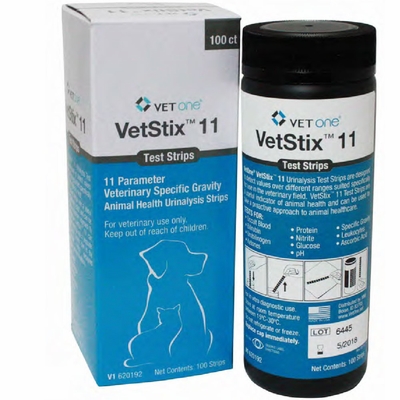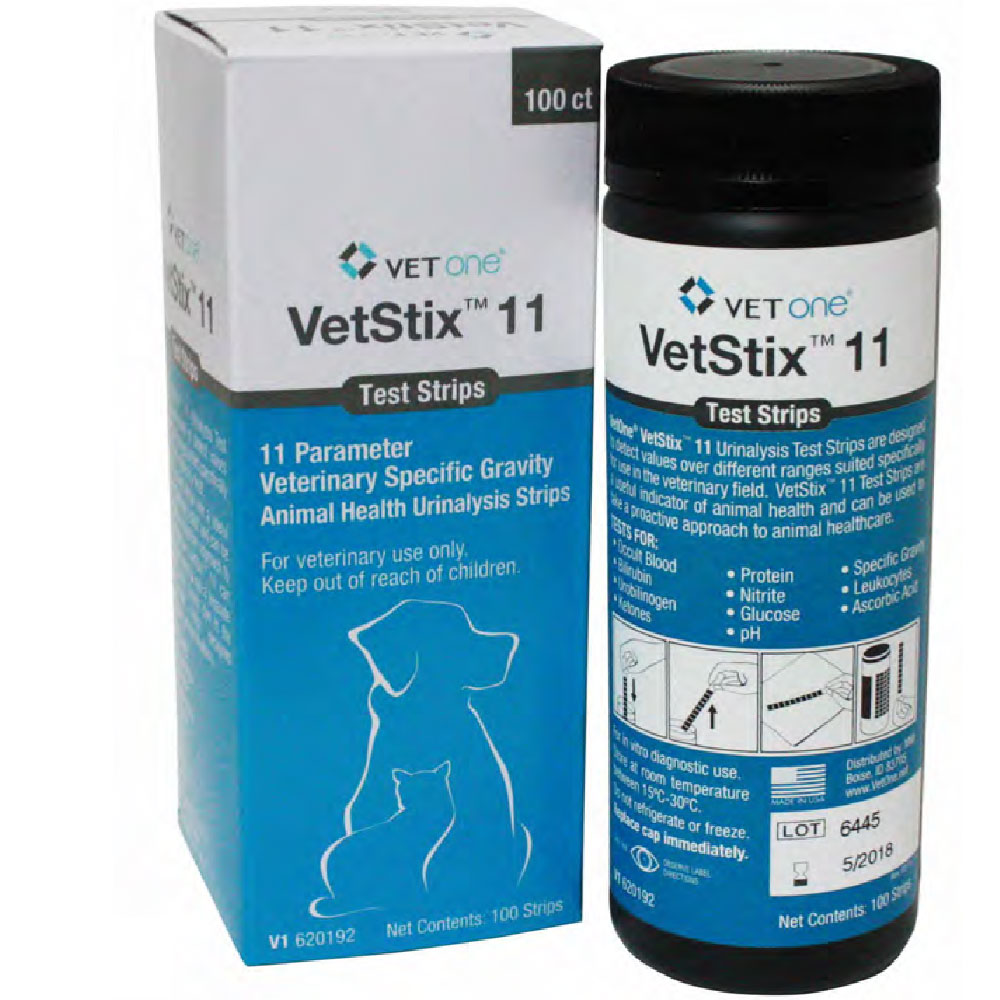Notice
This is our Rock-Bottom-Price! Sorry, Promotional offers do not apply (See Exclusions.)
Description
VetStix™ 11SG Urine Test Strips includes improvements and features designed specifically to provide reliable urinalysis results for veterinary practices and laboratories and offer diagnostic reliability.
- Shelf-life of all analytes is 30 months as opposed to 24 months.
- Specific Gravity is reliably determined to values of 1.07 as opposed to 1.06. Adequate renal concentrating capacity in dogs or cats can be determined making it a more reliable vet tool.
- Stable glucose chemistry pads allow reliable results for the full 30 month shelf-life of the product. High glucose values indicative of diabetic conditions will not be missed.
- Erroneous reductions in pH are avoided with Vetstix-11 strips. Incorporated strip technology helps prevent runoff of chemistry into neighboring pads. To prevent any chance that runoff from the highly acidic protein test pads can cause incorrect reduction in pH results, the Vetstix-11 strips are placed in a safe position - two test pads removed from the protein pad.
- Vetstix-11 reliably detects the presence of ascorbic acid (Vitamin C) in urine often present from supplemented feeds and vitamin supplements. Ascorbate has been shown to give under value or false negative glucose results with urine ascorbate levels of only 25mg/dl. Ascorbate may also affect Bilirubin, Nitrite, Blood, Leukocyte and Urobilinogen levels. Vetstix-11 insures that your clinical judgment is best served when the value of Vitamin C in urine is reliably known.
Vetstix-11 Vet features a reliable eleven parameter urinalysis strip:
- Occult Blood
- Bilirubin
- Urobilinogen
- Ketones
- Protein
- Nitrite
- Glucose
- pH
- Specific Gravity
- Leukocytes
- Ascorbic Acid
Useful Information
TEST PROCEDURE:
- Remove a VetStix™ 11 test strip from the bottle and replace the cap immediately.
- Examine the strip for any discoloration or darkening of the reagent pads. If present, deterioration may be indicated; discard the strip.
- Dip the strip completely into a well-mixed, uncentrifuged urine specimen for no more than one second. Remove excess urine by tapping the plastic film gently against the rim of the urine container or by gently blotting the edge on absorbent paper.
- Under a good light source, compare the test results with the color chart provided on the test bottle label. Keep the test strip in horizontal position to avoid interaction of the chemical pads from excessive urine.
Read test results within 30 – 60 seconds (leukocytes: 90 – 120 seconds). Changes in color that appear only along the edges of the area or after more than two min-utes are not significant.
RESULTS:
The results are obtained by direct comparison of test strip with the color chart printed on the bottle label.
QUALITY CONTROL:
Reaction of reagent strips should be confirmed by testing known positive and negative spec-imens or multiple analyte controls containing normal and abnormal amounts of each of the analytes being tested.
LIMITATIONS:
VetStix™ 11 strips measure only urine chemical properties. A complete urinalysis also includes physical and microscopic examination of urine sediment.
URINE 24-HOUR VOLUME (ml/kg)1:
Dog (24-50), Cat (18-25), Horse (8-30), Cattle (16-50), Sheep (10-40), Goat (10-40), Pig (20-80)
COLOR1:
Urine color will vary between species, but is normally some shade of yellow depending on the con-centration. Abnormal color changes in the urine could be due to drugs, increased urinary pigments or red blood cells. Occasionally, unusual colors may be caused by dyes associated with food or drugs.
CLARITY1:
Urine is normally transparent. In small ani-mals, turbidity or the lack of clarity suggests the presence of cells, casts, or crystals. Often refrigeration will cause the sedimentation of crystals in the urine, producing a cloudy appearance. This is usually of no significance.
ODOR1:
Urine has a characteristic smell that varies slightly by species and concentration of the sample. A particularly foul odor may occur in the presence of bac-teria. Thus, strong smelling urine is common in cases of infection. Sweet smelling urine can also indicate abnor-mal renal function so it is always important to note any strong odor associated with animal urine.
SEDIMENTATION:
Urine sedimentation may contain cells, casts and crystals and is examined microscopi-cally after centrifugation of the urine sample. A very small amount of all of the above mentioned sediments is nor-mal. Concern begins when any of these components is significantly elevated.
Substances that cause abnormal urine color, such as drugs containing azo dyes, nitrofurantoin and riboflavin may affect the readability of reagent areas on urinalysis reagent strips. The color development on the reagent pad may be masked, or a color reaction may be pro-duced on the pad that could be interpreted visually as a false positive. It is therefore recommended that in case of doubt the test should be repeated after withdrawal of the medication.
BLOOD:
False positive reactions can occur due to traces of detergents containing peroxide or other interfering compounds.
BILIRUBIN:
In individual cases small amounts of bilirubin can be detected in urine samples from dogs, although there is no indication of illness. High concen-trations of nitrite inhibit the test. Prolonged exposure of the urine sample to light can cause oxidation resulting in lower or false negative values. Excreted traces of dye and medication of red color can simulate a positive result.
UROBILINOGEN:
The test is restricted through higher concentrations of formaldehyde. Prolonged exposure of the urine sample to light can cause oxidization resulting in lower or false negative values. Higher or false positive re-sults can be caused by traces of dye or medication. Higher amounts of bilirubin show up yellow on the test field.
KETONES:
A ketoacidosis can also be caused through beta-hydroxybutyrate which, however, is not determined by the test strip. High concentrations of phenyl ketones interfere, altering the color reaction. Phthalein com-pounds produce red color tones on the test field.
PROTEIN:
False positive results could be shown due to extremely alkaline urine (pH>9), resulting from traces of dis-infectants or various types of medication.
NITRITE:
A false positive reaction could occur due to dye excreted in the urine. False negative results can occur during antibiotic therapy.
GLUCOSE:
False positive reactions can be caused by traces of detergents containing peroxide or other interfering ingredients. pH: Highly alkaline urine (pH>9) can lead to a false positive reaction on the protein test field.
SPECIFIC GRAVITY1:
The test determines the ionic con-centrations in urine. Non-ionic elements such as glucose or urea are not analyzed. Therefore it is recommended that the urine density is checked using a refractometer or a hydrometer.
LEUKOCYTES:
A weak reaction can be expected in the case of protein excretions of over 500 mg/dl and a glucose concentration over 2 g/dl. Excretion of dyed compounds could cover up the reaction color.
ASCORBIC ACID:
False positive reaction may be obtained with other reducing agent.
PRECAUTIONS:
- Do not use test beyond the expiration date.
- Reagent strips should always be stored in their desiccated vial and should be kept tightly capped.
- Protect reagent strips from moisture, heat and light.
- Handle all specimens as if capable of transmitting disease.
- For in vitro diagnostic use.
- Do not touch the test area.
STORAGE:
Store at room temperature between 15°C and 30°C (59°F to 86°F). Do not store test strips in refrigerator or freezer. Do not expose test strips to moisture, heat or light.
SPECIMEN COLLECTION:
Voided, manual expression of bladder, catheterization and cystocentesis (preferred) meth-ods can be used. Collect urine in a clean, dry, unused con-tainer. Test urine as soon as possible after collection. If testing cannot be performed within an hour after voiding, refrigerate the specimen immediately and allow to come to room tem-perature before testing. It is important to use a fresh, well-mixed, uncentrifuged urine for best results.


